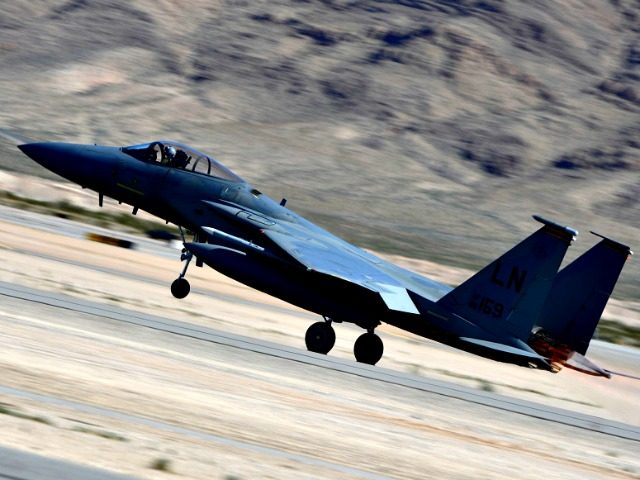WASHINGTON, D.C. – The Air Force is considering retiring the F-15C Eagle to free up money for newer platforms that could face a future enemy in battle.
The revelation came earlier this week during a House Armed Services Readiness Subcommittee hearing and set off concerns for lawmakers worried about gaps in air-to-air fighting capability.
Air Force Lt. Gen. L. Scott Rice, director of the Air National Guard, during the hearing, confirmed a plan to retire the F-15C/D fleet and replacing them with the F-16.
“There is a risk in changing any of our force structure decisions,” he acknowledged. “But specifically on the F-16 with the F-15, there are capabilities we can add and provide on the F-16 that will provide us a gap as we try to go into the future.”
Air Force Maj. Gen. Scott West, the Air Force’s director of current operations and deputy chief of staff for operations, said that would entail recapitalizing the F-16C with an improved radar.
He said doing so would enable the Air Force to make “other choices, either for modernization or grow end strength, without having multiple different systems to maintain.”
“It balances the choices that we have to make. The F-15C has served the nation well, as have its pilots for decades. And it was our air superiority fighter; now the F-22 has taken that role,” he said.
Rep. Martha McSally (R-AZ) expressed concern that the F-16C would not be a perfect replacement for the F-15.
“Comparing the capabilities side by side, we all need to be careful through that analysis. That an F-16 with an upgraded radar does not meet the same capabilities as an F-15,” she said.
“But I realize the funding challenges that you have as you go through this decision process, but it doesn’t bring the same capability that the F- 15C does with the expertise in air-to-air,” she added.
West called the move “pre-decisional.”
Rice added that planning for 2019 began last fall, and it included “four or five different things.”
“One of the options is retiring the F-15Cs and then replacing them with F-16s with upgraded radars. Can we do that? Is that a plan and time-wise? Is it the capability we want? Those are still in planning choices and we’re talking about those,” he said.
McSally also expressed concern for F-15C units who would need retraining to shift to the F-16C – which she said could make even fewer air forces battle ready.
“You now have a bunch of pilots who are qualified and capable and want airplanes and we’re already in a readiness crisis. And if you’re not retraining everybody to another aircraft, that does have, in the midst of a crisis, a bit of a short-term dip in readiness as well just as far as the capabilities and qualifications of those that are flying,” she said.
West acknowledged it would mean taking forces “off the line” for awhile, but said delaying modernization of the Air Force to take on a high-end fight is more urgent.
“Given the fact that our technology advantage that we enjoy today is lessening, it’s important that we also achieve modernization as rapidly as possible. So we’re going to have to take some units off the line to achieve the transition. But I think sooner is better, given that the investments that are being made by China and Russia particularly are pretty significant,” he said.
Some lawmakers seemed receptive to the argument that the Air Force needed to prepare for a future fight.
Rep. Vicki Hartzler (R-MO) noted an Air Force statistic that only 50 percent of combat air forces were prepared for a “high-end fight” such as might be fought over the South China Sea or Eastern Europe.
“And many of our air-to-air fighters were designed and built during the late 1970s and cannot face new threats, such as the Chinese J-20, without capability enhancements and service life extension,” she added.
Later she tweeted: “Modernization can no longer be delayed.”
In HASC hrg. on readiness of @usairforce. "Our avg. age of AF aircraft is 27 yrs old. Modernization can no longer be delayed." pic.twitter.com/7Dn0iZaIbe
— Rep. Vicky Hartzler (@RepHartzler) March 22, 2017

COMMENTS
Please let us know if you're having issues with commenting.